Leadership and Management: Roles, Theories, and Operational Efficiency
VerifiedAdded on 2020/10/05
|17
|4769
|277
Report
AI Summary
This report provides a comprehensive analysis of leadership and management principles, focusing on the roles of leaders and managers within Abbott Risk Consulting Ltd. It explores the characteristics of effective leaders and managers, differentiating their functions and responsibilities. The report delves into various leadership theories, including contingency, relationship, and situational theories, evaluating their strengths and weaknesses. It examines the application of leadership and management in different situational contexts, such as customer acquisition, employee engagement, and change management. Furthermore, it analyzes key approaches to operations management, emphasizing its importance and value in achieving business objectives. The report also evaluates factors within the business environment that impact operational management and decision-making, concluding with an assessment of how leaders and managers can improve operational efficiency to meet business goals. Overall, this report offers valuable insights into effective leadership and management practices.
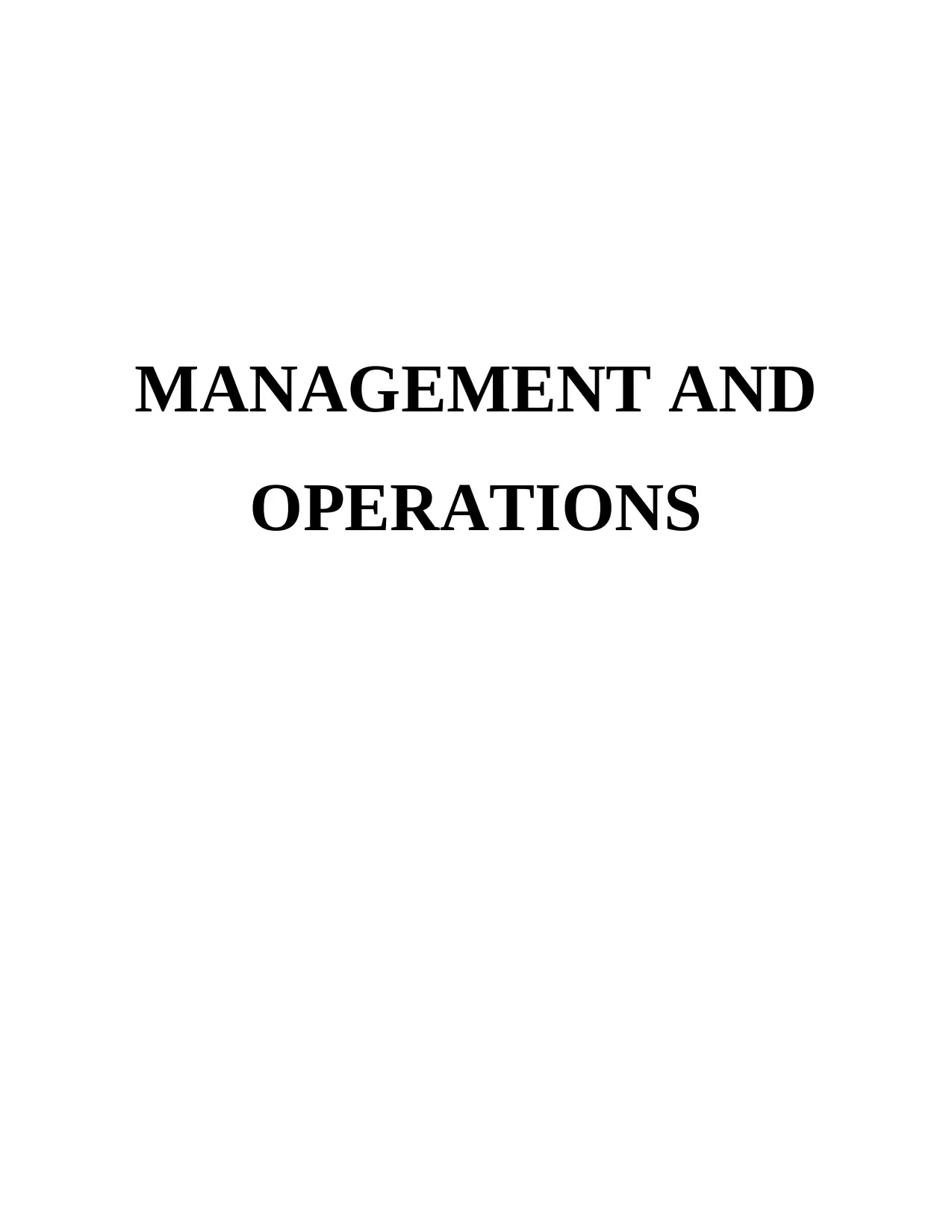
MANAGEMENT AND
OPERATIONS
OPERATIONS
Paraphrase This Document
Need a fresh take? Get an instant paraphrase of this document with our AI Paraphraser
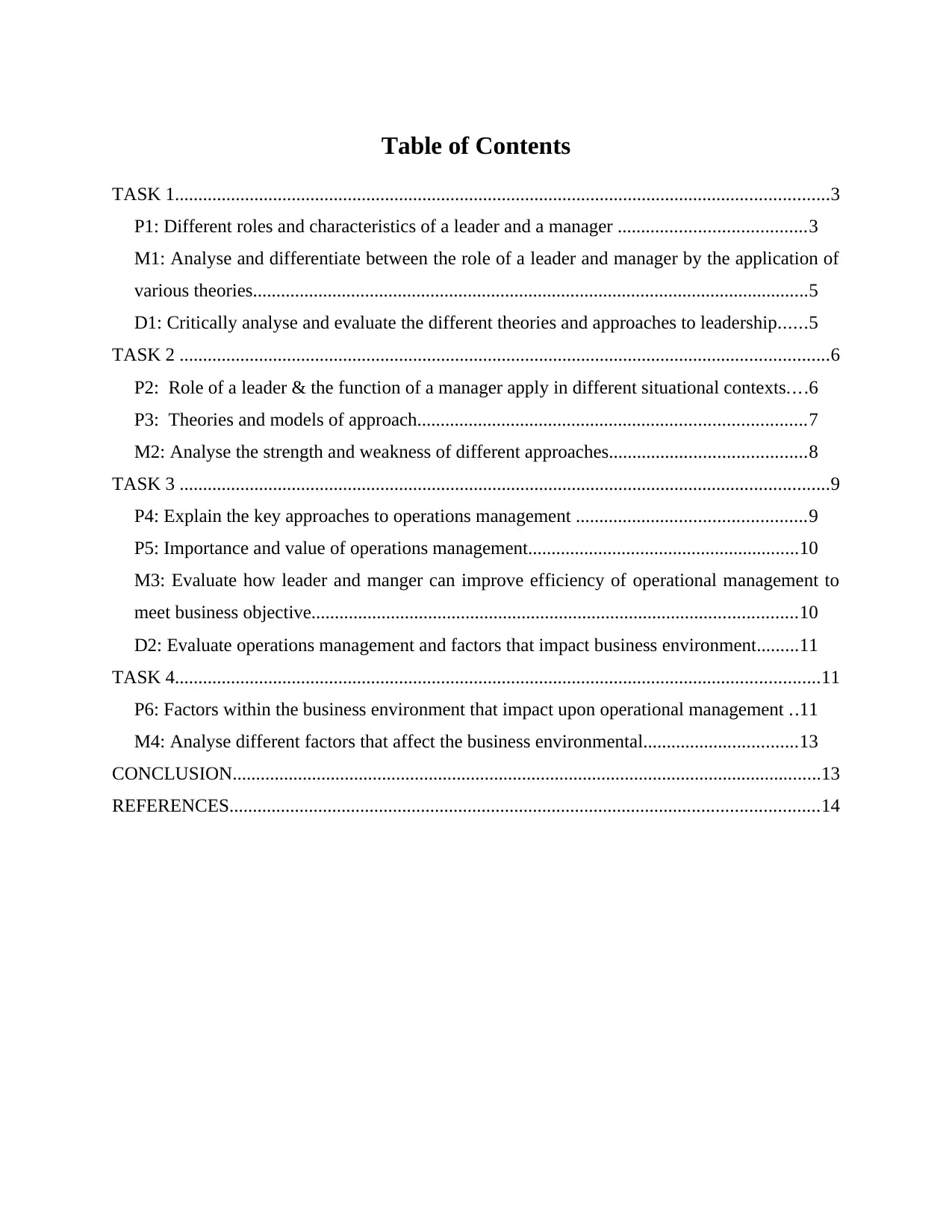
Table of Contents
TASK 1............................................................................................................................................3
P1: Different roles and characteristics of a leader and a manager ........................................3
M1: Analyse and differentiate between the role of a leader and manager by the application of
various theories.......................................................................................................................5
D1: Critically analyse and evaluate the different theories and approaches to leadership......5
TASK 2 ...........................................................................................................................................6
P2: Role of a leader & the function of a manager apply in different situational contexts....6
P3: Theories and models of approach...................................................................................7
M2: Analyse the strength and weakness of different approaches..........................................8
TASK 3 ...........................................................................................................................................9
P4: Explain the key approaches to operations management .................................................9
P5: Importance and value of operations management..........................................................10
M3: Evaluate how leader and manger can improve efficiency of operational management to
meet business objective........................................................................................................10
D2: Evaluate operations management and factors that impact business environment.........11
TASK 4..........................................................................................................................................11
P6: Factors within the business environment that impact upon operational management ..11
M4: Analyse different factors that affect the business environmental.................................13
CONCLUSION..............................................................................................................................13
REFERENCES..............................................................................................................................14
TASK 1............................................................................................................................................3
P1: Different roles and characteristics of a leader and a manager ........................................3
M1: Analyse and differentiate between the role of a leader and manager by the application of
various theories.......................................................................................................................5
D1: Critically analyse and evaluate the different theories and approaches to leadership......5
TASK 2 ...........................................................................................................................................6
P2: Role of a leader & the function of a manager apply in different situational contexts....6
P3: Theories and models of approach...................................................................................7
M2: Analyse the strength and weakness of different approaches..........................................8
TASK 3 ...........................................................................................................................................9
P4: Explain the key approaches to operations management .................................................9
P5: Importance and value of operations management..........................................................10
M3: Evaluate how leader and manger can improve efficiency of operational management to
meet business objective........................................................................................................10
D2: Evaluate operations management and factors that impact business environment.........11
TASK 4..........................................................................................................................................11
P6: Factors within the business environment that impact upon operational management ..11
M4: Analyse different factors that affect the business environmental.................................13
CONCLUSION..............................................................................................................................13
REFERENCES..............................................................................................................................14
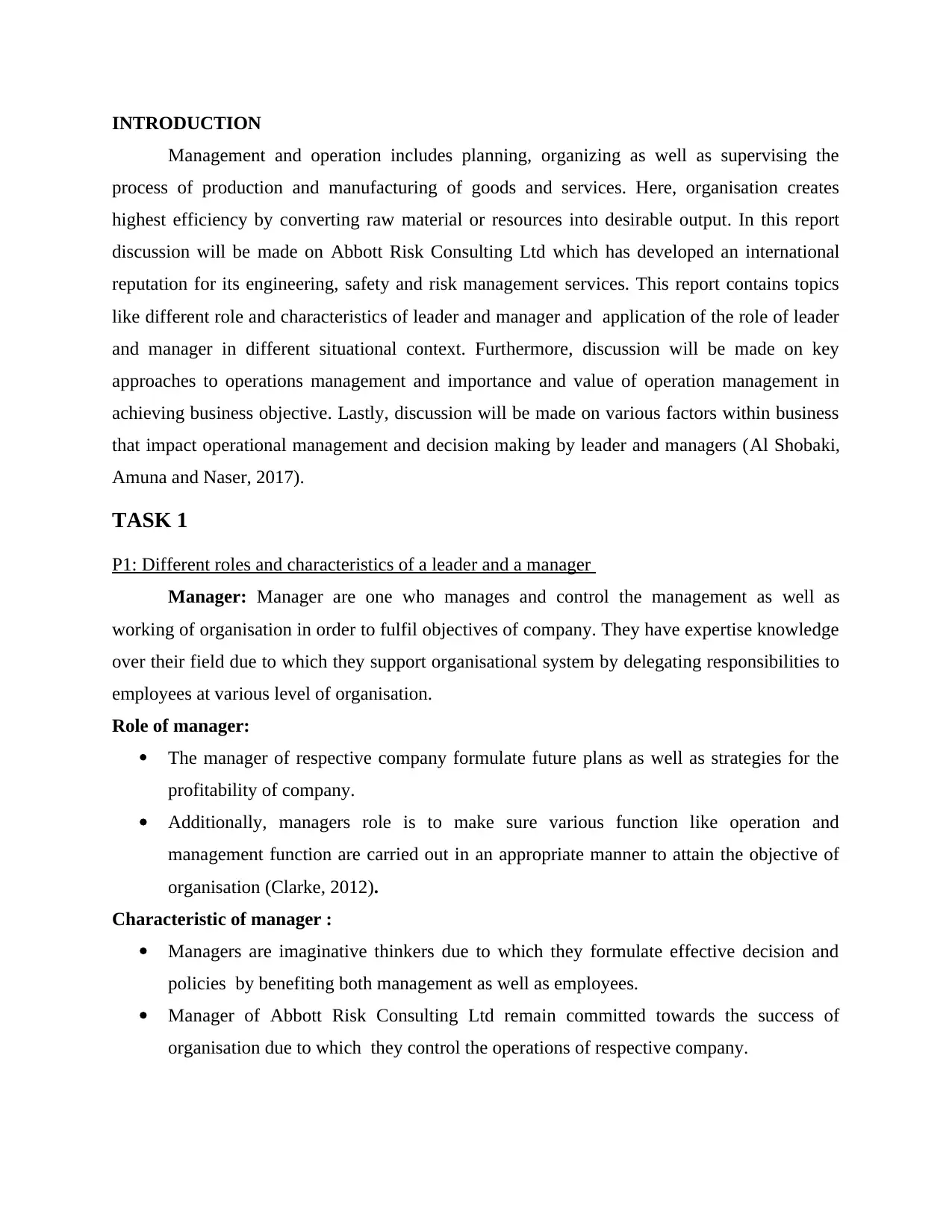
INTRODUCTION
Management and operation includes planning, organizing as well as supervising the
process of production and manufacturing of goods and services. Here, organisation creates
highest efficiency by converting raw material or resources into desirable output. In this report
discussion will be made on Abbott Risk Consulting Ltd which has developed an international
reputation for its engineering, safety and risk management services. This report contains topics
like different role and characteristics of leader and manager and application of the role of leader
and manager in different situational context. Furthermore, discussion will be made on key
approaches to operations management and importance and value of operation management in
achieving business objective. Lastly, discussion will be made on various factors within business
that impact operational management and decision making by leader and managers (Al Shobaki,
Amuna and Naser, 2017).
TASK 1
P1: Different roles and characteristics of a leader and a manager
Manager: Manager are one who manages and control the management as well as
working of organisation in order to fulfil objectives of company. They have expertise knowledge
over their field due to which they support organisational system by delegating responsibilities to
employees at various level of organisation.
Role of manager:
The manager of respective company formulate future plans as well as strategies for the
profitability of company.
Additionally, managers role is to make sure various function like operation and
management function are carried out in an appropriate manner to attain the objective of
organisation (Clarke, 2012).
Characteristic of manager :
Managers are imaginative thinkers due to which they formulate effective decision and
policies by benefiting both management as well as employees.
Manager of Abbott Risk Consulting Ltd remain committed towards the success of
organisation due to which they control the operations of respective company.
Management and operation includes planning, organizing as well as supervising the
process of production and manufacturing of goods and services. Here, organisation creates
highest efficiency by converting raw material or resources into desirable output. In this report
discussion will be made on Abbott Risk Consulting Ltd which has developed an international
reputation for its engineering, safety and risk management services. This report contains topics
like different role and characteristics of leader and manager and application of the role of leader
and manager in different situational context. Furthermore, discussion will be made on key
approaches to operations management and importance and value of operation management in
achieving business objective. Lastly, discussion will be made on various factors within business
that impact operational management and decision making by leader and managers (Al Shobaki,
Amuna and Naser, 2017).
TASK 1
P1: Different roles and characteristics of a leader and a manager
Manager: Manager are one who manages and control the management as well as
working of organisation in order to fulfil objectives of company. They have expertise knowledge
over their field due to which they support organisational system by delegating responsibilities to
employees at various level of organisation.
Role of manager:
The manager of respective company formulate future plans as well as strategies for the
profitability of company.
Additionally, managers role is to make sure various function like operation and
management function are carried out in an appropriate manner to attain the objective of
organisation (Clarke, 2012).
Characteristic of manager :
Managers are imaginative thinkers due to which they formulate effective decision and
policies by benefiting both management as well as employees.
Manager of Abbott Risk Consulting Ltd remain committed towards the success of
organisation due to which they control the operations of respective company.
⊘ This is a preview!⊘
Do you want full access?
Subscribe today to unlock all pages.

Trusted by 1+ million students worldwide
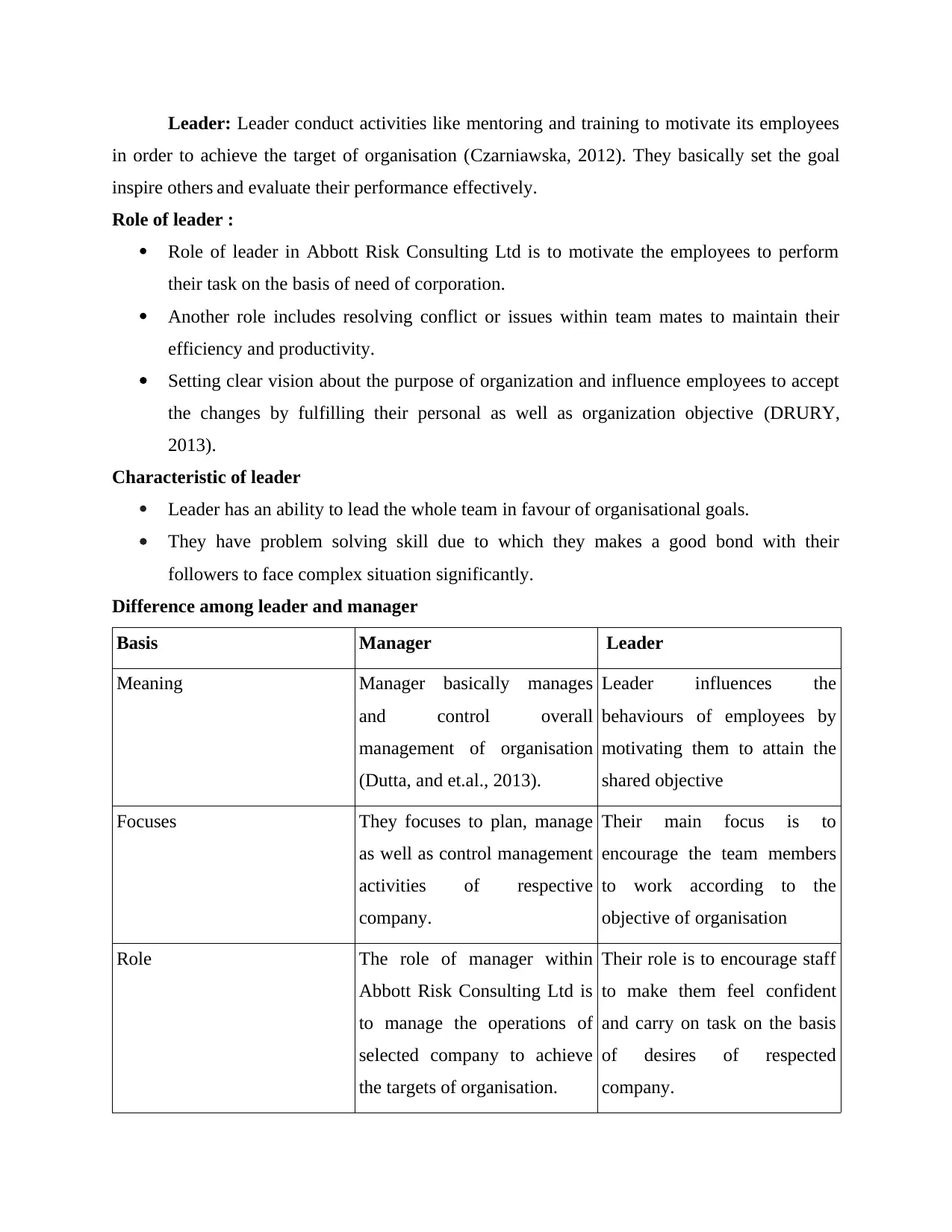
Leader: Leader conduct activities like mentoring and training to motivate its employees
in order to achieve the target of organisation (Czarniawska, 2012). They basically set the goal
inspire others and evaluate their performance effectively.
Role of leader :
Role of leader in Abbott Risk Consulting Ltd is to motivate the employees to perform
their task on the basis of need of corporation.
Another role includes resolving conflict or issues within team mates to maintain their
efficiency and productivity.
Setting clear vision about the purpose of organization and influence employees to accept
the changes by fulfilling their personal as well as organization objective (DRURY,
2013).
Characteristic of leader
Leader has an ability to lead the whole team in favour of organisational goals.
They have problem solving skill due to which they makes a good bond with their
followers to face complex situation significantly.
Difference among leader and manager
Basis Manager Leader
Meaning Manager basically manages
and control overall
management of organisation
(Dutta, and et.al., 2013).
Leader influences the
behaviours of employees by
motivating them to attain the
shared objective
Focuses They focuses to plan, manage
as well as control management
activities of respective
company.
Their main focus is to
encourage the team members
to work according to the
objective of organisation
Role The role of manager within
Abbott Risk Consulting Ltd is
to manage the operations of
selected company to achieve
the targets of organisation.
Their role is to encourage staff
to make them feel confident
and carry on task on the basis
of desires of respected
company.
in order to achieve the target of organisation (Czarniawska, 2012). They basically set the goal
inspire others and evaluate their performance effectively.
Role of leader :
Role of leader in Abbott Risk Consulting Ltd is to motivate the employees to perform
their task on the basis of need of corporation.
Another role includes resolving conflict or issues within team mates to maintain their
efficiency and productivity.
Setting clear vision about the purpose of organization and influence employees to accept
the changes by fulfilling their personal as well as organization objective (DRURY,
2013).
Characteristic of leader
Leader has an ability to lead the whole team in favour of organisational goals.
They have problem solving skill due to which they makes a good bond with their
followers to face complex situation significantly.
Difference among leader and manager
Basis Manager Leader
Meaning Manager basically manages
and control overall
management of organisation
(Dutta, and et.al., 2013).
Leader influences the
behaviours of employees by
motivating them to attain the
shared objective
Focuses They focuses to plan, manage
as well as control management
activities of respective
company.
Their main focus is to
encourage the team members
to work according to the
objective of organisation
Role The role of manager within
Abbott Risk Consulting Ltd is
to manage the operations of
selected company to achieve
the targets of organisation.
Their role is to encourage staff
to make them feel confident
and carry on task on the basis
of desires of respected
company.
Paraphrase This Document
Need a fresh take? Get an instant paraphrase of this document with our AI Paraphraser
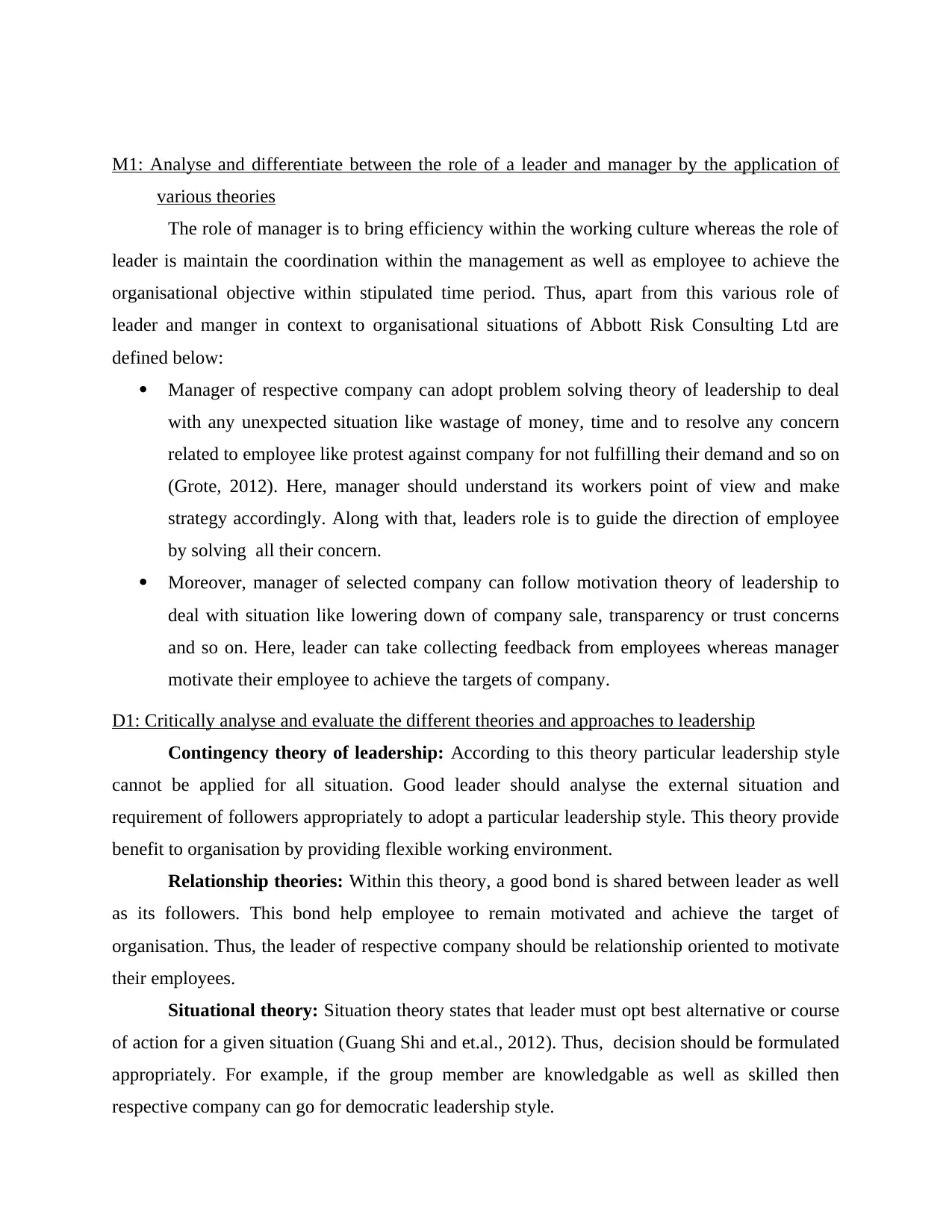
M1: Analyse and differentiate between the role of a leader and manager by the application of
various theories
The role of manager is to bring efficiency within the working culture whereas the role of
leader is maintain the coordination within the management as well as employee to achieve the
organisational objective within stipulated time period. Thus, apart from this various role of
leader and manger in context to organisational situations of Abbott Risk Consulting Ltd are
defined below:
Manager of respective company can adopt problem solving theory of leadership to deal
with any unexpected situation like wastage of money, time and to resolve any concern
related to employee like protest against company for not fulfilling their demand and so on
(Grote, 2012). Here, manager should understand its workers point of view and make
strategy accordingly. Along with that, leaders role is to guide the direction of employee
by solving all their concern.
Moreover, manager of selected company can follow motivation theory of leadership to
deal with situation like lowering down of company sale, transparency or trust concerns
and so on. Here, leader can take collecting feedback from employees whereas manager
motivate their employee to achieve the targets of company.
D1: Critically analyse and evaluate the different theories and approaches to leadership
Contingency theory of leadership: According to this theory particular leadership style
cannot be applied for all situation. Good leader should analyse the external situation and
requirement of followers appropriately to adopt a particular leadership style. This theory provide
benefit to organisation by providing flexible working environment.
Relationship theories: Within this theory, a good bond is shared between leader as well
as its followers. This bond help employee to remain motivated and achieve the target of
organisation. Thus, the leader of respective company should be relationship oriented to motivate
their employees.
Situational theory: Situation theory states that leader must opt best alternative or course
of action for a given situation (Guang Shi and et.al., 2012). Thus, decision should be formulated
appropriately. For example, if the group member are knowledgable as well as skilled then
respective company can go for democratic leadership style.
various theories
The role of manager is to bring efficiency within the working culture whereas the role of
leader is maintain the coordination within the management as well as employee to achieve the
organisational objective within stipulated time period. Thus, apart from this various role of
leader and manger in context to organisational situations of Abbott Risk Consulting Ltd are
defined below:
Manager of respective company can adopt problem solving theory of leadership to deal
with any unexpected situation like wastage of money, time and to resolve any concern
related to employee like protest against company for not fulfilling their demand and so on
(Grote, 2012). Here, manager should understand its workers point of view and make
strategy accordingly. Along with that, leaders role is to guide the direction of employee
by solving all their concern.
Moreover, manager of selected company can follow motivation theory of leadership to
deal with situation like lowering down of company sale, transparency or trust concerns
and so on. Here, leader can take collecting feedback from employees whereas manager
motivate their employee to achieve the targets of company.
D1: Critically analyse and evaluate the different theories and approaches to leadership
Contingency theory of leadership: According to this theory particular leadership style
cannot be applied for all situation. Good leader should analyse the external situation and
requirement of followers appropriately to adopt a particular leadership style. This theory provide
benefit to organisation by providing flexible working environment.
Relationship theories: Within this theory, a good bond is shared between leader as well
as its followers. This bond help employee to remain motivated and achieve the target of
organisation. Thus, the leader of respective company should be relationship oriented to motivate
their employees.
Situational theory: Situation theory states that leader must opt best alternative or course
of action for a given situation (Guang Shi and et.al., 2012). Thus, decision should be formulated
appropriately. For example, if the group member are knowledgable as well as skilled then
respective company can go for democratic leadership style.
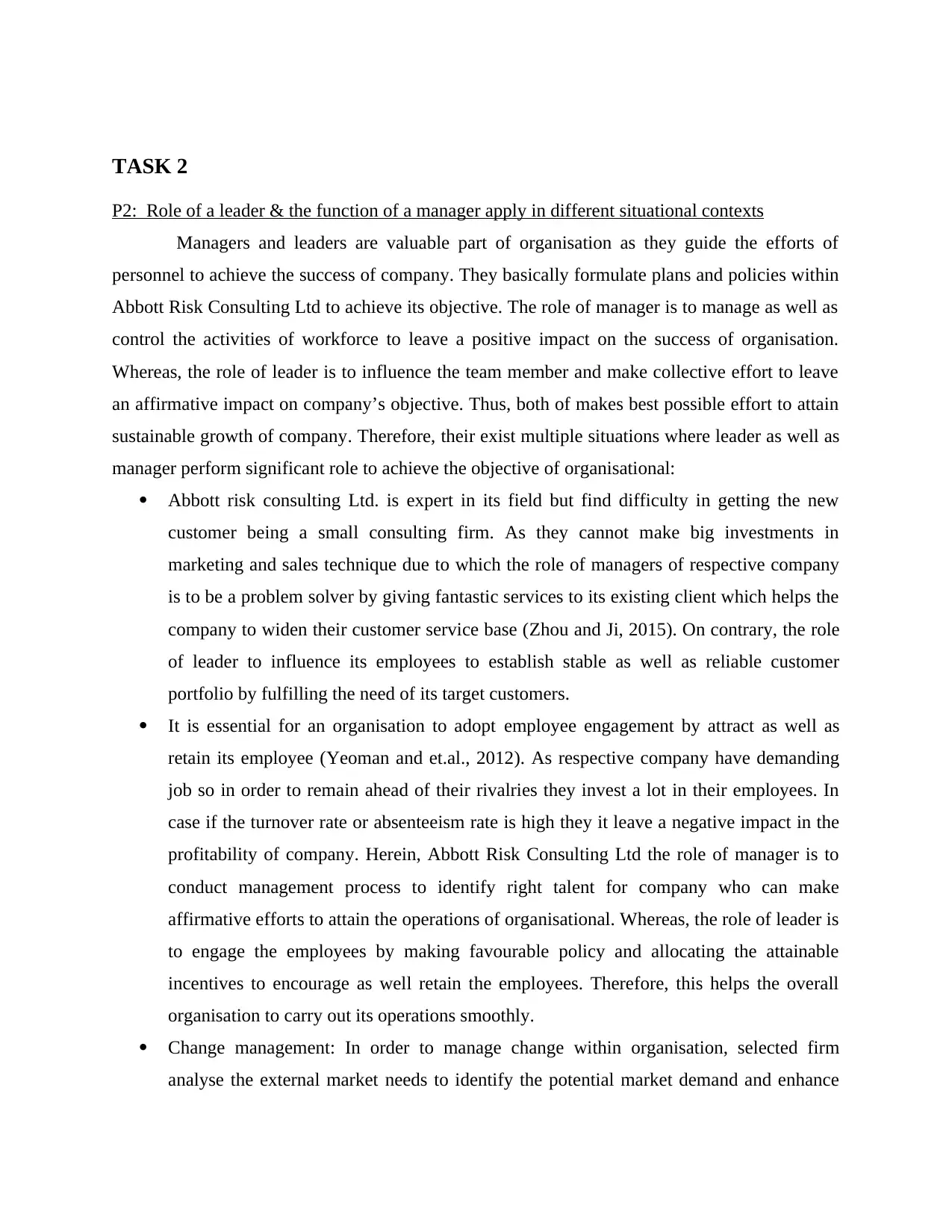
TASK 2
P2: Role of a leader & the function of a manager apply in different situational contexts
Managers and leaders are valuable part of organisation as they guide the efforts of
personnel to achieve the success of company. They basically formulate plans and policies within
Abbott Risk Consulting Ltd to achieve its objective. The role of manager is to manage as well as
control the activities of workforce to leave a positive impact on the success of organisation.
Whereas, the role of leader is to influence the team member and make collective effort to leave
an affirmative impact on company’s objective. Thus, both of makes best possible effort to attain
sustainable growth of company. Therefore, their exist multiple situations where leader as well as
manager perform significant role to achieve the objective of organisational:
Abbott risk consulting Ltd. is expert in its field but find difficulty in getting the new
customer being a small consulting firm. As they cannot make big investments in
marketing and sales technique due to which the role of managers of respective company
is to be a problem solver by giving fantastic services to its existing client which helps the
company to widen their customer service base (Zhou and Ji, 2015). On contrary, the role
of leader to influence its employees to establish stable as well as reliable customer
portfolio by fulfilling the need of its target customers.
It is essential for an organisation to adopt employee engagement by attract as well as
retain its employee (Yeoman and et.al., 2012). As respective company have demanding
job so in order to remain ahead of their rivalries they invest a lot in their employees. In
case if the turnover rate or absenteeism rate is high they it leave a negative impact in the
profitability of company. Herein, Abbott Risk Consulting Ltd the role of manager is to
conduct management process to identify right talent for company who can make
affirmative efforts to attain the operations of organisational. Whereas, the role of leader is
to engage the employees by making favourable policy and allocating the attainable
incentives to encourage as well retain the employees. Therefore, this helps the overall
organisation to carry out its operations smoothly.
Change management: In order to manage change within organisation, selected firm
analyse the external market needs to identify the potential market demand and enhance
P2: Role of a leader & the function of a manager apply in different situational contexts
Managers and leaders are valuable part of organisation as they guide the efforts of
personnel to achieve the success of company. They basically formulate plans and policies within
Abbott Risk Consulting Ltd to achieve its objective. The role of manager is to manage as well as
control the activities of workforce to leave a positive impact on the success of organisation.
Whereas, the role of leader is to influence the team member and make collective effort to leave
an affirmative impact on company’s objective. Thus, both of makes best possible effort to attain
sustainable growth of company. Therefore, their exist multiple situations where leader as well as
manager perform significant role to achieve the objective of organisational:
Abbott risk consulting Ltd. is expert in its field but find difficulty in getting the new
customer being a small consulting firm. As they cannot make big investments in
marketing and sales technique due to which the role of managers of respective company
is to be a problem solver by giving fantastic services to its existing client which helps the
company to widen their customer service base (Zhou and Ji, 2015). On contrary, the role
of leader to influence its employees to establish stable as well as reliable customer
portfolio by fulfilling the need of its target customers.
It is essential for an organisation to adopt employee engagement by attract as well as
retain its employee (Yeoman and et.al., 2012). As respective company have demanding
job so in order to remain ahead of their rivalries they invest a lot in their employees. In
case if the turnover rate or absenteeism rate is high they it leave a negative impact in the
profitability of company. Herein, Abbott Risk Consulting Ltd the role of manager is to
conduct management process to identify right talent for company who can make
affirmative efforts to attain the operations of organisational. Whereas, the role of leader is
to engage the employees by making favourable policy and allocating the attainable
incentives to encourage as well retain the employees. Therefore, this helps the overall
organisation to carry out its operations smoothly.
Change management: In order to manage change within organisation, selected firm
analyse the external market needs to identify the potential market demand and enhance
⊘ This is a preview!⊘
Do you want full access?
Subscribe today to unlock all pages.

Trusted by 1+ million students worldwide
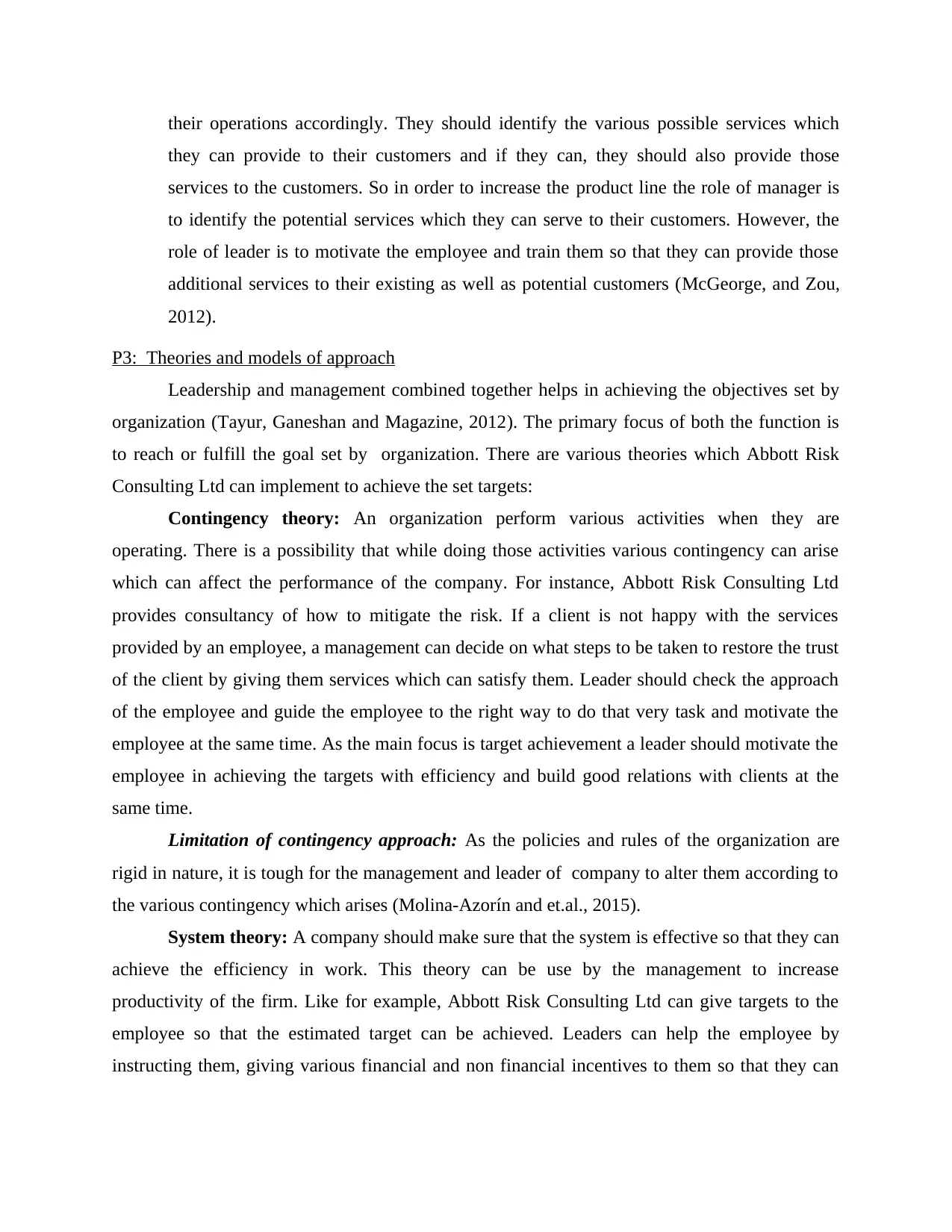
their operations accordingly. They should identify the various possible services which
they can provide to their customers and if they can, they should also provide those
services to the customers. So in order to increase the product line the role of manager is
to identify the potential services which they can serve to their customers. However, the
role of leader is to motivate the employee and train them so that they can provide those
additional services to their existing as well as potential customers (McGeorge, and Zou,
2012).
P3: Theories and models of approach
Leadership and management combined together helps in achieving the objectives set by
organization (Tayur, Ganeshan and Magazine, 2012). The primary focus of both the function is
to reach or fulfill the goal set by organization. There are various theories which Abbott Risk
Consulting Ltd can implement to achieve the set targets:
Contingency theory: An organization perform various activities when they are
operating. There is a possibility that while doing those activities various contingency can arise
which can affect the performance of the company. For instance, Abbott Risk Consulting Ltd
provides consultancy of how to mitigate the risk. If a client is not happy with the services
provided by an employee, a management can decide on what steps to be taken to restore the trust
of the client by giving them services which can satisfy them. Leader should check the approach
of the employee and guide the employee to the right way to do that very task and motivate the
employee at the same time. As the main focus is target achievement a leader should motivate the
employee in achieving the targets with efficiency and build good relations with clients at the
same time.
Limitation of contingency approach: As the policies and rules of the organization are
rigid in nature, it is tough for the management and leader of company to alter them according to
the various contingency which arises (Molina-Azorín and et.al., 2015).
System theory: A company should make sure that the system is effective so that they can
achieve the efficiency in work. This theory can be use by the management to increase
productivity of the firm. Like for example, Abbott Risk Consulting Ltd can give targets to the
employee so that the estimated target can be achieved. Leaders can help the employee by
instructing them, giving various financial and non financial incentives to them so that they can
they can provide to their customers and if they can, they should also provide those
services to the customers. So in order to increase the product line the role of manager is
to identify the potential services which they can serve to their customers. However, the
role of leader is to motivate the employee and train them so that they can provide those
additional services to their existing as well as potential customers (McGeorge, and Zou,
2012).
P3: Theories and models of approach
Leadership and management combined together helps in achieving the objectives set by
organization (Tayur, Ganeshan and Magazine, 2012). The primary focus of both the function is
to reach or fulfill the goal set by organization. There are various theories which Abbott Risk
Consulting Ltd can implement to achieve the set targets:
Contingency theory: An organization perform various activities when they are
operating. There is a possibility that while doing those activities various contingency can arise
which can affect the performance of the company. For instance, Abbott Risk Consulting Ltd
provides consultancy of how to mitigate the risk. If a client is not happy with the services
provided by an employee, a management can decide on what steps to be taken to restore the trust
of the client by giving them services which can satisfy them. Leader should check the approach
of the employee and guide the employee to the right way to do that very task and motivate the
employee at the same time. As the main focus is target achievement a leader should motivate the
employee in achieving the targets with efficiency and build good relations with clients at the
same time.
Limitation of contingency approach: As the policies and rules of the organization are
rigid in nature, it is tough for the management and leader of company to alter them according to
the various contingency which arises (Molina-Azorín and et.al., 2015).
System theory: A company should make sure that the system is effective so that they can
achieve the efficiency in work. This theory can be use by the management to increase
productivity of the firm. Like for example, Abbott Risk Consulting Ltd can give targets to the
employee so that the estimated target can be achieved. Leaders can help the employee by
instructing them, giving various financial and non financial incentives to them so that they can
Paraphrase This Document
Need a fresh take? Get an instant paraphrase of this document with our AI Paraphraser
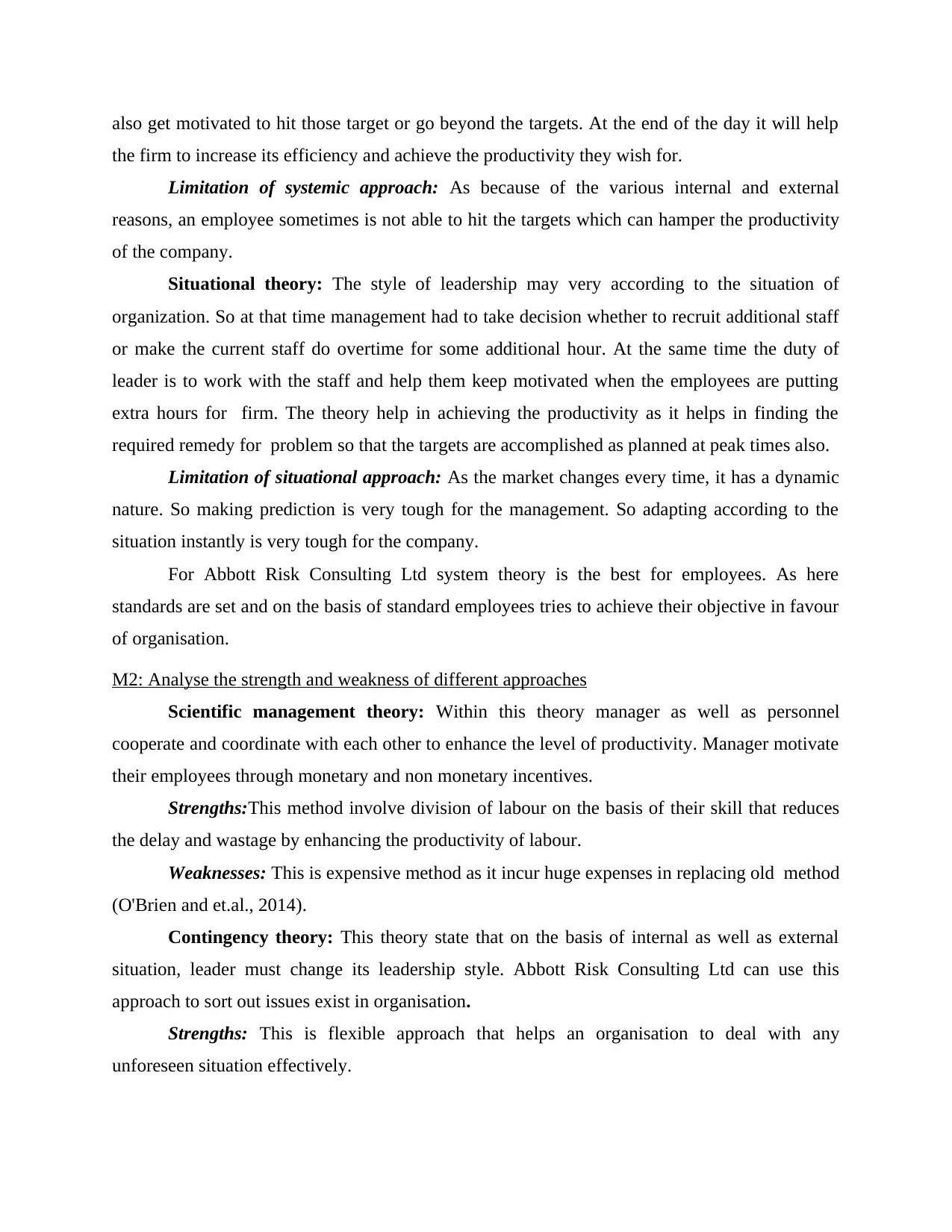
also get motivated to hit those target or go beyond the targets. At the end of the day it will help
the firm to increase its efficiency and achieve the productivity they wish for.
Limitation of systemic approach: As because of the various internal and external
reasons, an employee sometimes is not able to hit the targets which can hamper the productivity
of the company.
Situational theory: The style of leadership may very according to the situation of
organization. So at that time management had to take decision whether to recruit additional staff
or make the current staff do overtime for some additional hour. At the same time the duty of
leader is to work with the staff and help them keep motivated when the employees are putting
extra hours for firm. The theory help in achieving the productivity as it helps in finding the
required remedy for problem so that the targets are accomplished as planned at peak times also.
Limitation of situational approach: As the market changes every time, it has a dynamic
nature. So making prediction is very tough for the management. So adapting according to the
situation instantly is very tough for the company.
For Abbott Risk Consulting Ltd system theory is the best for employees. As here
standards are set and on the basis of standard employees tries to achieve their objective in favour
of organisation.
M2: Analyse the strength and weakness of different approaches
Scientific management theory: Within this theory manager as well as personnel
cooperate and coordinate with each other to enhance the level of productivity. Manager motivate
their employees through monetary and non monetary incentives.
Strengths:This method involve division of labour on the basis of their skill that reduces
the delay and wastage by enhancing the productivity of labour.
Weaknesses: This is expensive method as it incur huge expenses in replacing old method
(O'Brien and et.al., 2014).
Contingency theory: This theory state that on the basis of internal as well as external
situation, leader must change its leadership style. Abbott Risk Consulting Ltd can use this
approach to sort out issues exist in organisation.
Strengths: This is flexible approach that helps an organisation to deal with any
unforeseen situation effectively.
the firm to increase its efficiency and achieve the productivity they wish for.
Limitation of systemic approach: As because of the various internal and external
reasons, an employee sometimes is not able to hit the targets which can hamper the productivity
of the company.
Situational theory: The style of leadership may very according to the situation of
organization. So at that time management had to take decision whether to recruit additional staff
or make the current staff do overtime for some additional hour. At the same time the duty of
leader is to work with the staff and help them keep motivated when the employees are putting
extra hours for firm. The theory help in achieving the productivity as it helps in finding the
required remedy for problem so that the targets are accomplished as planned at peak times also.
Limitation of situational approach: As the market changes every time, it has a dynamic
nature. So making prediction is very tough for the management. So adapting according to the
situation instantly is very tough for the company.
For Abbott Risk Consulting Ltd system theory is the best for employees. As here
standards are set and on the basis of standard employees tries to achieve their objective in favour
of organisation.
M2: Analyse the strength and weakness of different approaches
Scientific management theory: Within this theory manager as well as personnel
cooperate and coordinate with each other to enhance the level of productivity. Manager motivate
their employees through monetary and non monetary incentives.
Strengths:This method involve division of labour on the basis of their skill that reduces
the delay and wastage by enhancing the productivity of labour.
Weaknesses: This is expensive method as it incur huge expenses in replacing old method
(O'Brien and et.al., 2014).
Contingency theory: This theory state that on the basis of internal as well as external
situation, leader must change its leadership style. Abbott Risk Consulting Ltd can use this
approach to sort out issues exist in organisation.
Strengths: This is flexible approach that helps an organisation to deal with any
unforeseen situation effectively.
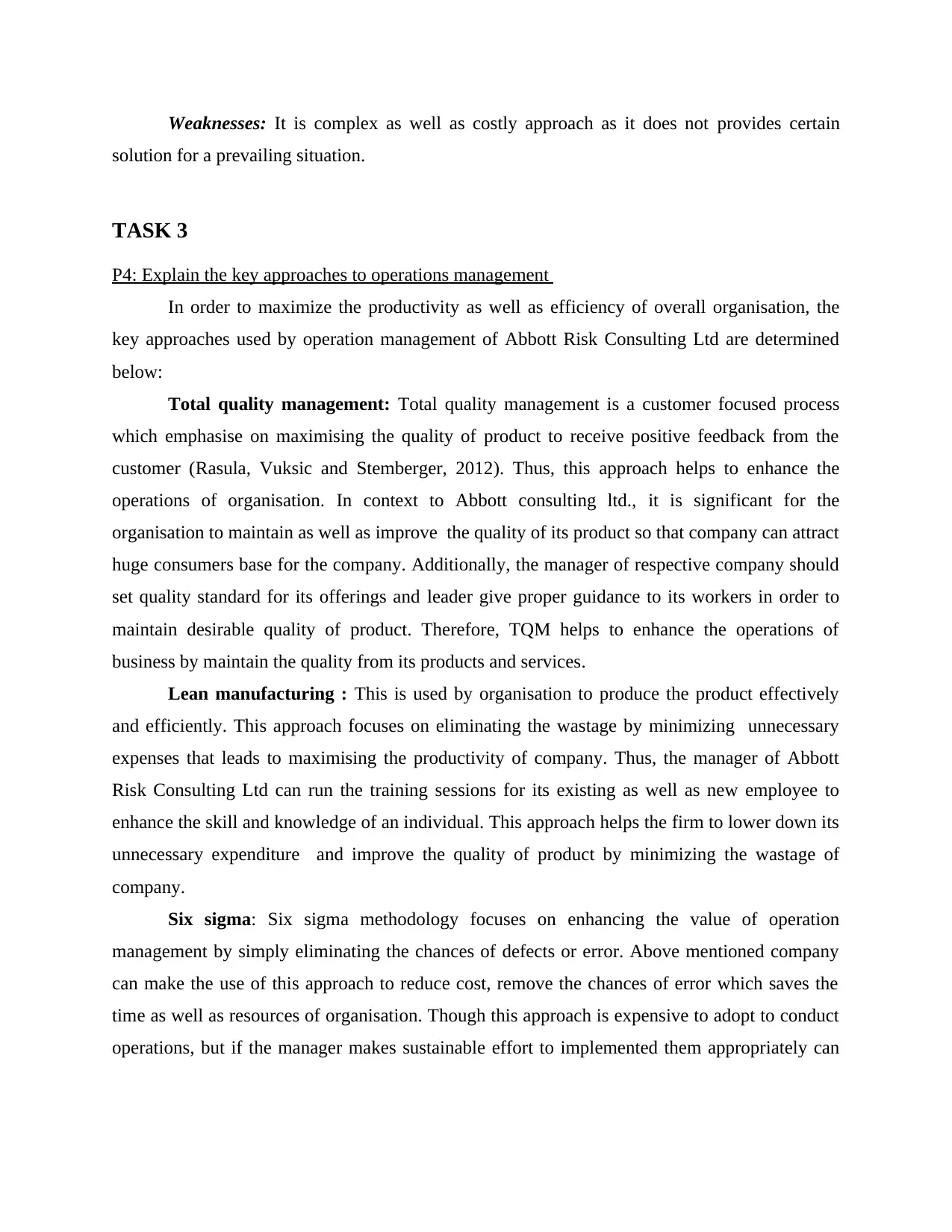
Weaknesses: It is complex as well as costly approach as it does not provides certain
solution for a prevailing situation.
TASK 3
P4: Explain the key approaches to operations management
In order to maximize the productivity as well as efficiency of overall organisation, the
key approaches used by operation management of Abbott Risk Consulting Ltd are determined
below:
Total quality management: Total quality management is a customer focused process
which emphasise on maximising the quality of product to receive positive feedback from the
customer (Rasula, Vuksic and Stemberger, 2012). Thus, this approach helps to enhance the
operations of organisation. In context to Abbott consulting ltd., it is significant for the
organisation to maintain as well as improve the quality of its product so that company can attract
huge consumers base for the company. Additionally, the manager of respective company should
set quality standard for its offerings and leader give proper guidance to its workers in order to
maintain desirable quality of product. Therefore, TQM helps to enhance the operations of
business by maintain the quality from its products and services.
Lean manufacturing : This is used by organisation to produce the product effectively
and efficiently. This approach focuses on eliminating the wastage by minimizing unnecessary
expenses that leads to maximising the productivity of company. Thus, the manager of Abbott
Risk Consulting Ltd can run the training sessions for its existing as well as new employee to
enhance the skill and knowledge of an individual. This approach helps the firm to lower down its
unnecessary expenditure and improve the quality of product by minimizing the wastage of
company.
Six sigma: Six sigma methodology focuses on enhancing the value of operation
management by simply eliminating the chances of defects or error. Above mentioned company
can make the use of this approach to reduce cost, remove the chances of error which saves the
time as well as resources of organisation. Though this approach is expensive to adopt to conduct
operations, but if the manager makes sustainable effort to implemented them appropriately can
solution for a prevailing situation.
TASK 3
P4: Explain the key approaches to operations management
In order to maximize the productivity as well as efficiency of overall organisation, the
key approaches used by operation management of Abbott Risk Consulting Ltd are determined
below:
Total quality management: Total quality management is a customer focused process
which emphasise on maximising the quality of product to receive positive feedback from the
customer (Rasula, Vuksic and Stemberger, 2012). Thus, this approach helps to enhance the
operations of organisation. In context to Abbott consulting ltd., it is significant for the
organisation to maintain as well as improve the quality of its product so that company can attract
huge consumers base for the company. Additionally, the manager of respective company should
set quality standard for its offerings and leader give proper guidance to its workers in order to
maintain desirable quality of product. Therefore, TQM helps to enhance the operations of
business by maintain the quality from its products and services.
Lean manufacturing : This is used by organisation to produce the product effectively
and efficiently. This approach focuses on eliminating the wastage by minimizing unnecessary
expenses that leads to maximising the productivity of company. Thus, the manager of Abbott
Risk Consulting Ltd can run the training sessions for its existing as well as new employee to
enhance the skill and knowledge of an individual. This approach helps the firm to lower down its
unnecessary expenditure and improve the quality of product by minimizing the wastage of
company.
Six sigma: Six sigma methodology focuses on enhancing the value of operation
management by simply eliminating the chances of defects or error. Above mentioned company
can make the use of this approach to reduce cost, remove the chances of error which saves the
time as well as resources of organisation. Though this approach is expensive to adopt to conduct
operations, but if the manager makes sustainable effort to implemented them appropriately can
⊘ This is a preview!⊘
Do you want full access?
Subscribe today to unlock all pages.

Trusted by 1+ million students worldwide
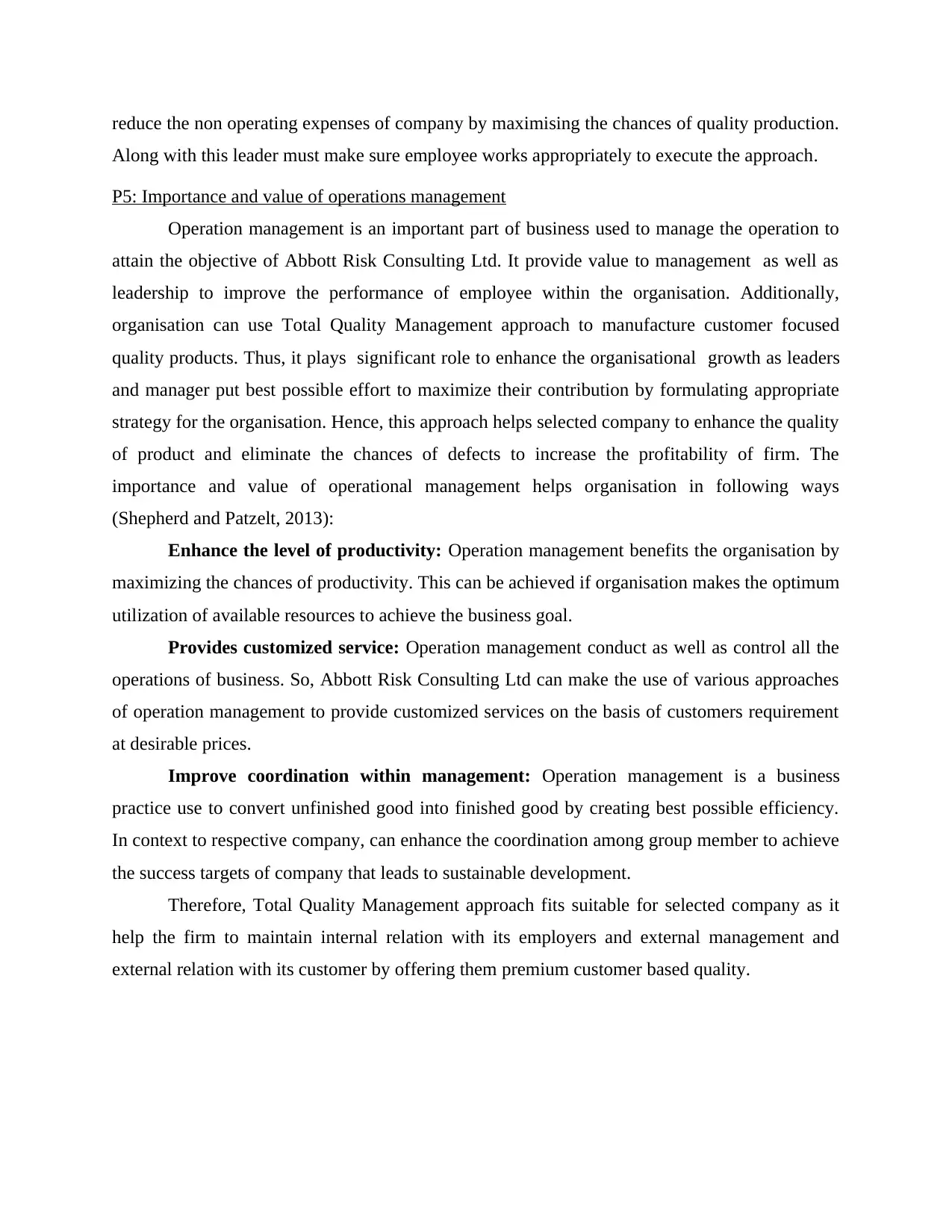
reduce the non operating expenses of company by maximising the chances of quality production.
Along with this leader must make sure employee works appropriately to execute the approach.
P5: Importance and value of operations management
Operation management is an important part of business used to manage the operation to
attain the objective of Abbott Risk Consulting Ltd. It provide value to management as well as
leadership to improve the performance of employee within the organisation. Additionally,
organisation can use Total Quality Management approach to manufacture customer focused
quality products. Thus, it plays significant role to enhance the organisational growth as leaders
and manager put best possible effort to maximize their contribution by formulating appropriate
strategy for the organisation. Hence, this approach helps selected company to enhance the quality
of product and eliminate the chances of defects to increase the profitability of firm. The
importance and value of operational management helps organisation in following ways
(Shepherd and Patzelt, 2013):
Enhance the level of productivity: Operation management benefits the organisation by
maximizing the chances of productivity. This can be achieved if organisation makes the optimum
utilization of available resources to achieve the business goal.
Provides customized service: Operation management conduct as well as control all the
operations of business. So, Abbott Risk Consulting Ltd can make the use of various approaches
of operation management to provide customized services on the basis of customers requirement
at desirable prices.
Improve coordination within management: Operation management is a business
practice use to convert unfinished good into finished good by creating best possible efficiency.
In context to respective company, can enhance the coordination among group member to achieve
the success targets of company that leads to sustainable development.
Therefore, Total Quality Management approach fits suitable for selected company as it
help the firm to maintain internal relation with its employers and external management and
external relation with its customer by offering them premium customer based quality.
Along with this leader must make sure employee works appropriately to execute the approach.
P5: Importance and value of operations management
Operation management is an important part of business used to manage the operation to
attain the objective of Abbott Risk Consulting Ltd. It provide value to management as well as
leadership to improve the performance of employee within the organisation. Additionally,
organisation can use Total Quality Management approach to manufacture customer focused
quality products. Thus, it plays significant role to enhance the organisational growth as leaders
and manager put best possible effort to maximize their contribution by formulating appropriate
strategy for the organisation. Hence, this approach helps selected company to enhance the quality
of product and eliminate the chances of defects to increase the profitability of firm. The
importance and value of operational management helps organisation in following ways
(Shepherd and Patzelt, 2013):
Enhance the level of productivity: Operation management benefits the organisation by
maximizing the chances of productivity. This can be achieved if organisation makes the optimum
utilization of available resources to achieve the business goal.
Provides customized service: Operation management conduct as well as control all the
operations of business. So, Abbott Risk Consulting Ltd can make the use of various approaches
of operation management to provide customized services on the basis of customers requirement
at desirable prices.
Improve coordination within management: Operation management is a business
practice use to convert unfinished good into finished good by creating best possible efficiency.
In context to respective company, can enhance the coordination among group member to achieve
the success targets of company that leads to sustainable development.
Therefore, Total Quality Management approach fits suitable for selected company as it
help the firm to maintain internal relation with its employers and external management and
external relation with its customer by offering them premium customer based quality.
Paraphrase This Document
Need a fresh take? Get an instant paraphrase of this document with our AI Paraphraser
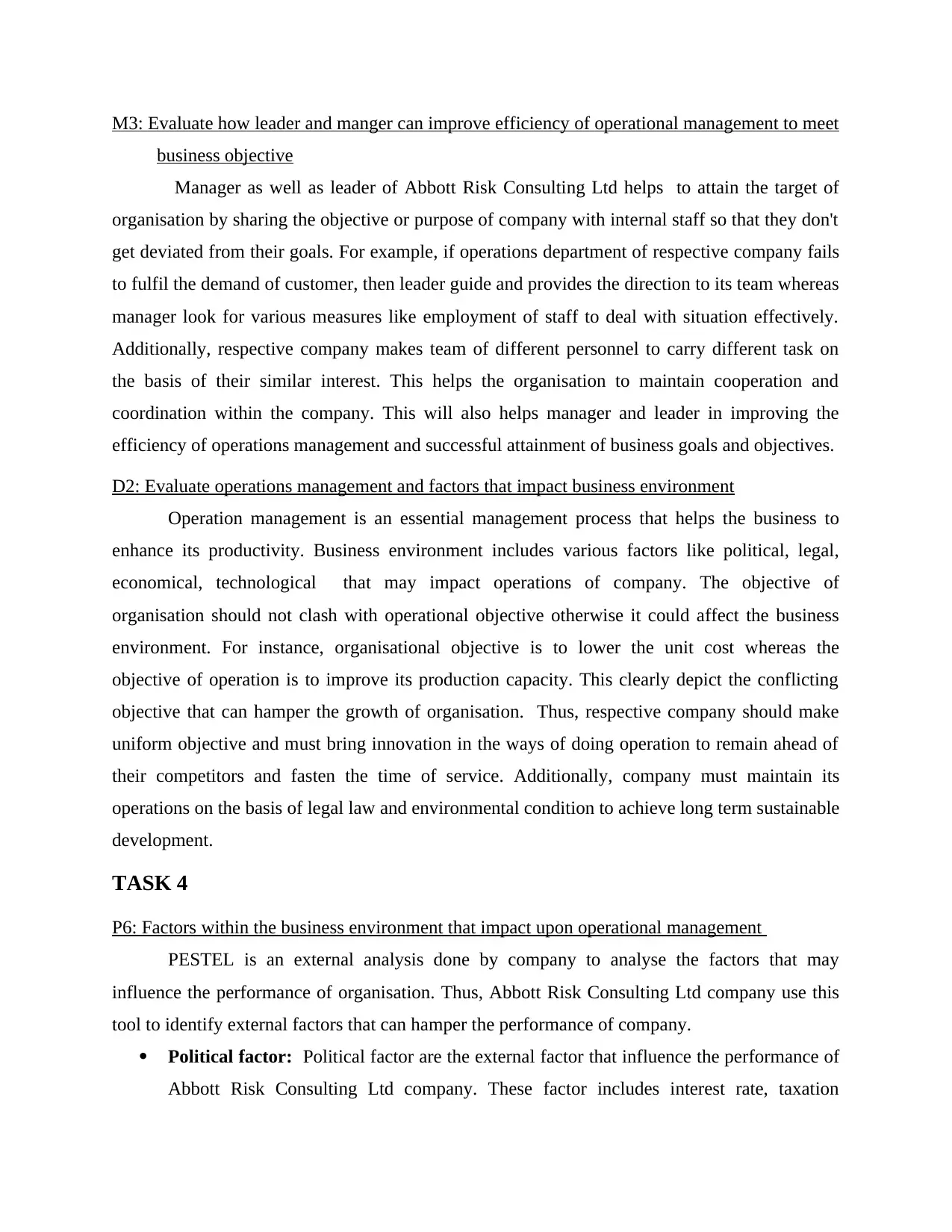
M3: Evaluate how leader and manger can improve efficiency of operational management to meet
business objective
Manager as well as leader of Abbott Risk Consulting Ltd helps to attain the target of
organisation by sharing the objective or purpose of company with internal staff so that they don't
get deviated from their goals. For example, if operations department of respective company fails
to fulfil the demand of customer, then leader guide and provides the direction to its team whereas
manager look for various measures like employment of staff to deal with situation effectively.
Additionally, respective company makes team of different personnel to carry different task on
the basis of their similar interest. This helps the organisation to maintain cooperation and
coordination within the company. This will also helps manager and leader in improving the
efficiency of operations management and successful attainment of business goals and objectives.
D2: Evaluate operations management and factors that impact business environment
Operation management is an essential management process that helps the business to
enhance its productivity. Business environment includes various factors like political, legal,
economical, technological that may impact operations of company. The objective of
organisation should not clash with operational objective otherwise it could affect the business
environment. For instance, organisational objective is to lower the unit cost whereas the
objective of operation is to improve its production capacity. This clearly depict the conflicting
objective that can hamper the growth of organisation. Thus, respective company should make
uniform objective and must bring innovation in the ways of doing operation to remain ahead of
their competitors and fasten the time of service. Additionally, company must maintain its
operations on the basis of legal law and environmental condition to achieve long term sustainable
development.
TASK 4
P6: Factors within the business environment that impact upon operational management
PESTEL is an external analysis done by company to analyse the factors that may
influence the performance of organisation. Thus, Abbott Risk Consulting Ltd company use this
tool to identify external factors that can hamper the performance of company.
Political factor: Political factor are the external factor that influence the performance of
Abbott Risk Consulting Ltd company. These factor includes interest rate, taxation
business objective
Manager as well as leader of Abbott Risk Consulting Ltd helps to attain the target of
organisation by sharing the objective or purpose of company with internal staff so that they don't
get deviated from their goals. For example, if operations department of respective company fails
to fulfil the demand of customer, then leader guide and provides the direction to its team whereas
manager look for various measures like employment of staff to deal with situation effectively.
Additionally, respective company makes team of different personnel to carry different task on
the basis of their similar interest. This helps the organisation to maintain cooperation and
coordination within the company. This will also helps manager and leader in improving the
efficiency of operations management and successful attainment of business goals and objectives.
D2: Evaluate operations management and factors that impact business environment
Operation management is an essential management process that helps the business to
enhance its productivity. Business environment includes various factors like political, legal,
economical, technological that may impact operations of company. The objective of
organisation should not clash with operational objective otherwise it could affect the business
environment. For instance, organisational objective is to lower the unit cost whereas the
objective of operation is to improve its production capacity. This clearly depict the conflicting
objective that can hamper the growth of organisation. Thus, respective company should make
uniform objective and must bring innovation in the ways of doing operation to remain ahead of
their competitors and fasten the time of service. Additionally, company must maintain its
operations on the basis of legal law and environmental condition to achieve long term sustainable
development.
TASK 4
P6: Factors within the business environment that impact upon operational management
PESTEL is an external analysis done by company to analyse the factors that may
influence the performance of organisation. Thus, Abbott Risk Consulting Ltd company use this
tool to identify external factors that can hamper the performance of company.
Political factor: Political factor are the external factor that influence the performance of
Abbott Risk Consulting Ltd company. These factor includes interest rate, taxation
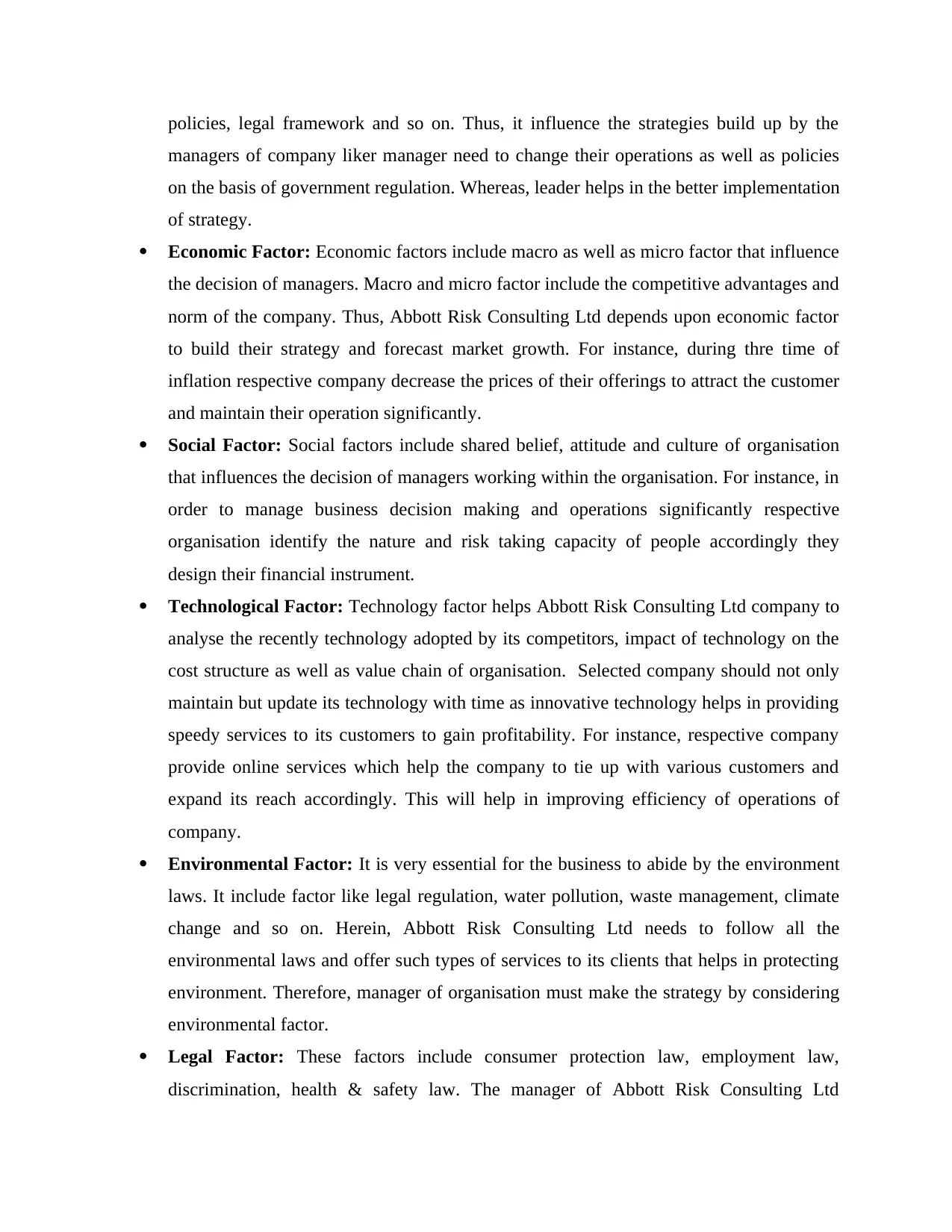
policies, legal framework and so on. Thus, it influence the strategies build up by the
managers of company liker manager need to change their operations as well as policies
on the basis of government regulation. Whereas, leader helps in the better implementation
of strategy.
Economic Factor: Economic factors include macro as well as micro factor that influence
the decision of managers. Macro and micro factor include the competitive advantages and
norm of the company. Thus, Abbott Risk Consulting Ltd depends upon economic factor
to build their strategy and forecast market growth. For instance, during thre time of
inflation respective company decrease the prices of their offerings to attract the customer
and maintain their operation significantly.
Social Factor: Social factors include shared belief, attitude and culture of organisation
that influences the decision of managers working within the organisation. For instance, in
order to manage business decision making and operations significantly respective
organisation identify the nature and risk taking capacity of people accordingly they
design their financial instrument.
Technological Factor: Technology factor helps Abbott Risk Consulting Ltd company to
analyse the recently technology adopted by its competitors, impact of technology on the
cost structure as well as value chain of organisation. Selected company should not only
maintain but update its technology with time as innovative technology helps in providing
speedy services to its customers to gain profitability. For instance, respective company
provide online services which help the company to tie up with various customers and
expand its reach accordingly. This will help in improving efficiency of operations of
company.
Environmental Factor: It is very essential for the business to abide by the environment
laws. It include factor like legal regulation, water pollution, waste management, climate
change and so on. Herein, Abbott Risk Consulting Ltd needs to follow all the
environmental laws and offer such types of services to its clients that helps in protecting
environment. Therefore, manager of organisation must make the strategy by considering
environmental factor.
Legal Factor: These factors include consumer protection law, employment law,
discrimination, health & safety law. The manager of Abbott Risk Consulting Ltd
managers of company liker manager need to change their operations as well as policies
on the basis of government regulation. Whereas, leader helps in the better implementation
of strategy.
Economic Factor: Economic factors include macro as well as micro factor that influence
the decision of managers. Macro and micro factor include the competitive advantages and
norm of the company. Thus, Abbott Risk Consulting Ltd depends upon economic factor
to build their strategy and forecast market growth. For instance, during thre time of
inflation respective company decrease the prices of their offerings to attract the customer
and maintain their operation significantly.
Social Factor: Social factors include shared belief, attitude and culture of organisation
that influences the decision of managers working within the organisation. For instance, in
order to manage business decision making and operations significantly respective
organisation identify the nature and risk taking capacity of people accordingly they
design their financial instrument.
Technological Factor: Technology factor helps Abbott Risk Consulting Ltd company to
analyse the recently technology adopted by its competitors, impact of technology on the
cost structure as well as value chain of organisation. Selected company should not only
maintain but update its technology with time as innovative technology helps in providing
speedy services to its customers to gain profitability. For instance, respective company
provide online services which help the company to tie up with various customers and
expand its reach accordingly. This will help in improving efficiency of operations of
company.
Environmental Factor: It is very essential for the business to abide by the environment
laws. It include factor like legal regulation, water pollution, waste management, climate
change and so on. Herein, Abbott Risk Consulting Ltd needs to follow all the
environmental laws and offer such types of services to its clients that helps in protecting
environment. Therefore, manager of organisation must make the strategy by considering
environmental factor.
Legal Factor: These factors include consumer protection law, employment law,
discrimination, health & safety law. The manager of Abbott Risk Consulting Ltd
⊘ This is a preview!⊘
Do you want full access?
Subscribe today to unlock all pages.

Trusted by 1+ million students worldwide
1 out of 17
Related Documents
Your All-in-One AI-Powered Toolkit for Academic Success.
+13062052269
info@desklib.com
Available 24*7 on WhatsApp / Email
![[object Object]](/_next/static/media/star-bottom.7253800d.svg)
Unlock your academic potential
Copyright © 2020–2025 A2Z Services. All Rights Reserved. Developed and managed by ZUCOL.





